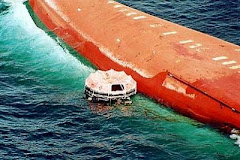
The Toya Maru (洞爺丸, Tōyamaru?) was a Japanese freightliner constructed by the Japanese National Railways which sank during a typhoon in the Tsugaru Strait between the Japanese islands of Hokkaidō and Honshū on September 26, 1954. It is said that 1153 people (Japanese National Railways announcement in September 1955) aboard were killed in the accident, however the exact number of fatalities remains unknown because there were victims who managed to ride the ship and those who forcedly cancelled their rides just before the incident.
The Toya Maru was launched on November 21, 1947. It was 118.7 meters (approximately 130 yards) long and 15.85 meters (60 ft) at its beam and it had a Gross Register Tonnage of 3,898 tons. It could accommodate 1,128 passengers and was operated by 120 crew. She covered the distance from Aomori to Hakodate in 4 hours and 30 minutes.
As early as 1950, it was fitted with Radar equipment, becoming one of the first Japanese sea liners to do so. It was used by the Emperor the month before her demise. It was also famous as the flag ship of the Tsugaru Strait.
Accident
The following refers to what happened on September 26, 1954 to the Toya Maru.
Typhoon No.15, Marie, which had blown through Honshū, was in the Sea of Japan at 12:00 hours on September 26, 1954, proceeding Northeast at a speed of more than 100 kilometers an hour. It was predicted to reach the Tsugaru Strait at around 17:00 hours.
At 11:00 hours, the Toya Maru arrived at Hakodate after its first journey that day from Aomori. She was originally scheduled to return at 14:40 hours, to arrive at Aomori just before Typhoon Mary. However, due to the expected storm, another ferry the Dai 11 Seikan Maru, a somewhat poorer quality vessel, could not depart on its scheduled journey to Hakodate. Therefore, passengers and vehicles were transferred to the Toya Maru delaying departure.
The captain of the Toya Maru decided to cancel its journey at 15:10 hours.
At 17:00 hours, following heavy rainfall in Hakodate, the weather cleared up and the outlook improved. The captain presuming that the Typhoon had now passed as predicted decided to proceed with the journey for Aomori. However, by this time the Typhoon had slowed and was predicted to stay over the strait for an entire day.
Strangely, the typhoon was gaining strength on Japan Sea. The Typhoon is considered to have already become an extratropical cyclone when it reached Japan, in recent years.
At 18:39 the Toya Maru departed from Hakodate with approximately 1,300 passengers aboard. Shortly thereafter the wind picked up coming from a SSE direction.
At 19:01, the Toya Maru lowered its anchor at the very side of Hakodate Port to wait for the weather to clear up again. However, due to the high winds, the anchor did not hold and the Toya Maru was cast adrift. Water entered to the engine room due to poor design of the vehicle decks, causing its steam engine to stop and the Toya Maru to become uncontrollable. The captain decided to beach the sea liner onto Nanae Beach, in the outskirts of Hakodate City.
At 22:26 hours, the Toya Maru beached and an SOS call was made. However the waves were so strong that the sea liner could no longer remain upright and at around 22:43 hours, the Toya Maru capsized and sank at sea several hundred meters off the shore of Hakodate. Of the 1,309 on board only 150 people survived, while 1,159 (1,041 passengers, 73 crew and 41 others) died.
Four other ferries sank in the same typhoon with a total loss of life of 1,430.






No comments:
Post a Comment